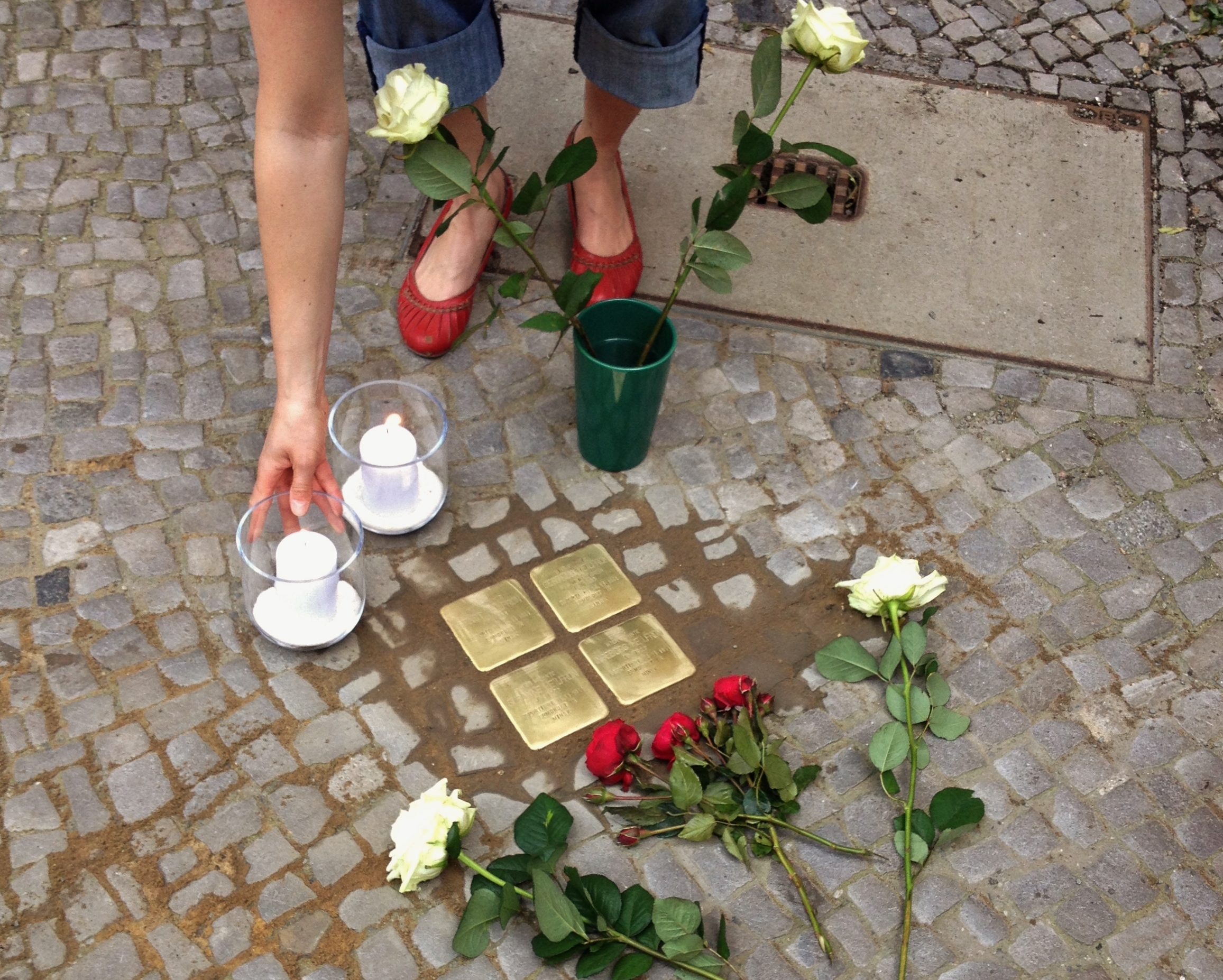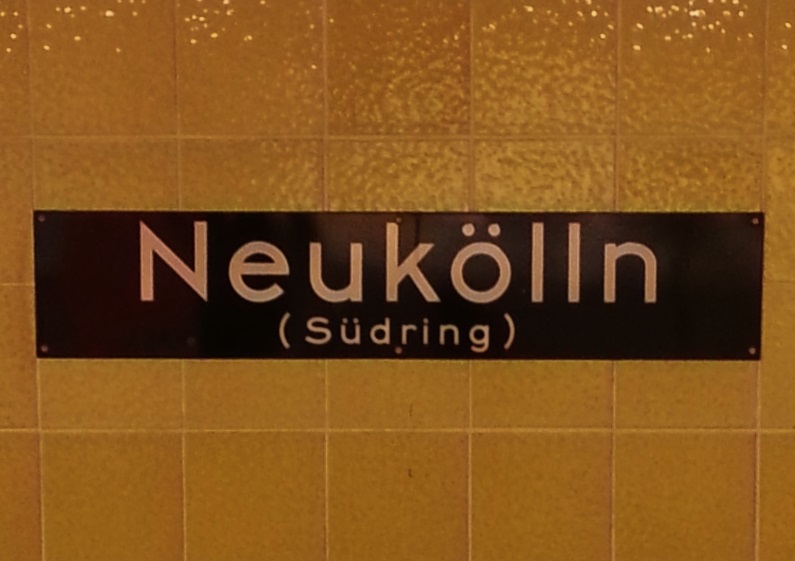Hier Wohnte // Neukölln’s newest Stolpersteine Holocaust memorials

If you live in Berlin and haven’t yet noticed the Stolpersteine, you haven’t been paying attention.
These little brass-covered cobblestones–or stumbling blocks, as the project name roughly translates to–are installed into the sidewalk in front of the last homes of Holocaust victims, each stone engraved with one individual’s name and basic details about their fate. While Berlin’s Holocaust Memorial, officially titled Memorial to the Murdered Jews of Europe, is quite something in all of its imposing, weighty magnitude, there is something much more subtly powerful about the Stolpersteine. They are scattered so quietly, with no fanfare or signage, in all corners of this city, bringing the past back into the present and standing as testament to the real human cost of that genocide. You could walk all over them without realizing it if you’re not paying attention. Pay attention.
 Many people don’t know that the Stolpersteine are the personal project of one man, and not state-sponsored. Since 1997, Berlin-born artist Gunter Demnig has been installing these little bronze memorials not only in Germany but also in various other European countries like Austria, Poland, and the Czech Republic. By now, he has personally made and installed more than 40,000 throughout Europe. Last week, Demnig was back in Berlin on a three-day whirlwind tour to install a total of 121 Stolpersteine at 58 locations around the city. Having found out about his Berlin dates in advance, I wrote to the Stolpersteine in Berlin organization to ask for locations and times, and had the privilege of being present at the installation of seven new stones in my neighbourhood, in Neukölln’s Friedelstraße.
Many people don’t know that the Stolpersteine are the personal project of one man, and not state-sponsored. Since 1997, Berlin-born artist Gunter Demnig has been installing these little bronze memorials not only in Germany but also in various other European countries like Austria, Poland, and the Czech Republic. By now, he has personally made and installed more than 40,000 throughout Europe. Last week, Demnig was back in Berlin on a three-day whirlwind tour to install a total of 121 Stolpersteine at 58 locations around the city. Having found out about his Berlin dates in advance, I wrote to the Stolpersteine in Berlin organization to ask for locations and times, and had the privilege of being present at the installation of seven new stones in my neighbourhood, in Neukölln’s Friedelstraße.

The event itself was efficient, bare-bones, quiet, and moving. Demnig and his assistant have their procedure so down pat, the whole thing is wordless: pry out existing cobblestones, dig some space, place Stolpersteine, mallet and wedge them into place, fill in cracks with dirt, sweep up the work site. Then each Stolpersteine is rinsed and wiped clean, the shining brass emerging brightly from the mud. Afterward, Demnig and crew briskly pack up and drive off in their van–there’s another site to rush to; a timetable to keep. 121 Stolpersteine in three days.
The first three stones installed at Friedelstr. 47 were to commemorate the Adler family: Simon, Rachel, and their son Heinrich. A press release from the Museum Neukölln said this about the family (translation mine):
After the Nazis came to power, Simon and Rachel Adler lost the egg shop they owned. Their son Heinrich was murdered in 1940 as part of a “euthanasia program.” His brothers Erich and Bernhard had by then already fled to Palestine and Denmark. Simon and Rachel were deported to Auschwitz on May 3, 1944 and murdered there.
Heinrich’s cobblestone lists the name of the institution where he was first committed in 1939, as well as the Nazi euthanasia program, Action T4, by which he was murdered. Next door, at Friedelstr. 49, are now four, new Stolpersteine for the Heilfron family: Ernst, Gertrud, and their two daughters Susanne and Ingeborg. The entire family was deported on Nov. 11, 1941–Susanne would have been 21 and Ingeborg only 14–and ended up in the Minsk ghetto, where all four died.
There is so much that I wonder about these families now. How did Simon and Rachel Adler pass those four years, alone, after their one son had been murdered and their other two sons fled for their lives? Was every day during those four years spent dreading that terrible knock on the door, the one that finally came just a year before the war came to an end? Did they know their neighbours, the Heilfron family? The Heilfrons were deported much earlier on, in 1941. Could the Adlers watch or listen as their neighbours were taken away?
 Weighty as the event was, I came away feeling inspired because I struck up a conversation at the end with a young woman who I had assumed was a relative of the Heilfron family (she had prepared flowers and candles) but actually turned out to just be a tenant in the building. Two years ago, she and her friends had decided to investigate whether their building was in need of some Stolpersteine of its own. They started researching district records and found that yes, a Jewish family had lived in their Haus. Over these two years, they did an incredible amount of research on the lives and fates of the Heilfrons and their relatives, and put all the documentation together in a binder, which they let me look through. Even more impressively, they raised all the money themselves (each Stolpersteine costs €120) by holding fundraiser parties in the building’s Hof and getting all the tenants to participate and chip in. It’s something I’ve thought of doing with my own building and I was so impressed by their dedication and commitment to seeing it through.
Weighty as the event was, I came away feeling inspired because I struck up a conversation at the end with a young woman who I had assumed was a relative of the Heilfron family (she had prepared flowers and candles) but actually turned out to just be a tenant in the building. Two years ago, she and her friends had decided to investigate whether their building was in need of some Stolpersteine of its own. They started researching district records and found that yes, a Jewish family had lived in their Haus. Over these two years, they did an incredible amount of research on the lives and fates of the Heilfrons and their relatives, and put all the documentation together in a binder, which they let me look through. Even more impressively, they raised all the money themselves (each Stolpersteine costs €120) by holding fundraiser parties in the building’s Hof and getting all the tenants to participate and chip in. It’s something I’ve thought of doing with my own building and I was so impressed by their dedication and commitment to seeing it through.
Main Stolpersteine website | Stolpersteine Berlin website with a searchable map of all the locations in the city


Ludwig
June 13, 2013Hi, I encourage you to start the research about the past inhabitants of your building. I am working with my neighbours on the story of ours and its a great process. I think that there is an important part of this memorial / art piece that is only revealed if you take part and it is the social dimension of it. Doing this research has brought our building community closer. Also everyone wants to economically contribute even friends who don’t even live here want to pay for a stone. As a non German I find this keen interest with curiosity as if after all this years society is finally able to look back and say, yes we carry some guilt and must do something about it.
We have also found addresses and information about relatives of the former inhabitants of our house and will try to involve the people who live in these other addresses at present, so the net widens. Nevertheless is important to know that the stones are laid in public land, so the authorisations of the neighbours living in a building facing the stones is not needed, but as I said it is desired because this is a social act.
We also found descendants of the families who lived in our building and invited them to the future stone placing.
Hilda
June 13, 2013Thanks for sharing! I’m very impressed by everything you’ve done with regards to ensuring your Haus becomes part of the Stolpersteine project. How incredible it would be to meet the descendants of those families, and to have them be part of the placing of their relatives’ stones. Do you know yet if they’ll be able to attend?
I agree with you that the social and community aspects of keeping the project going are so important. I feel like these apartments we are living in still belong, in a way, to the people who were forcibly torn away from them. I am really touched by the idea of neighbours coming together to recognize and commemorate the memory of something that happened in this space that we share. I guess it’s poetic that while once, people would have looked away and done nothing while their neighbours were taken away and murdered, now we can at least come together to pay homage to it in some small way.
On that note, I’m going to commence research into my Haus’s past ASAP!
kathryn
July 2, 2013I remember seeing these when I visited Berlin and thinking they were such a fitting tribute– but I assumed that the city was funding them officially! it means so much that people are motivated to create these remembrances. I wish we had something similar here in Srebrenica… but it would be very controversial…
Isa
November 3, 2013Interesting. Although I’ve seen many Stolpersteine, I had absolutely no idea they were someone’s personal project. Totally blown back by that.